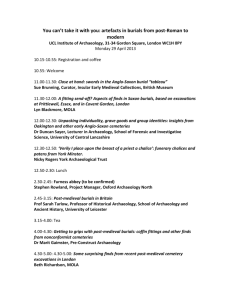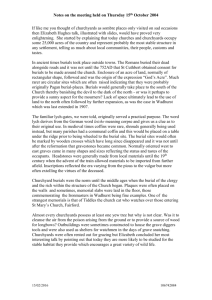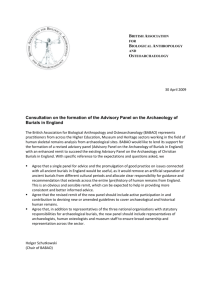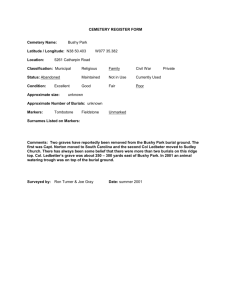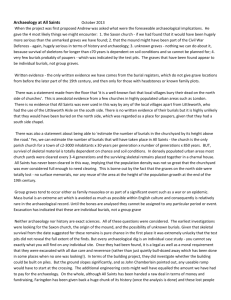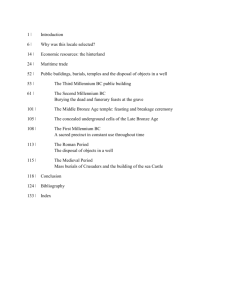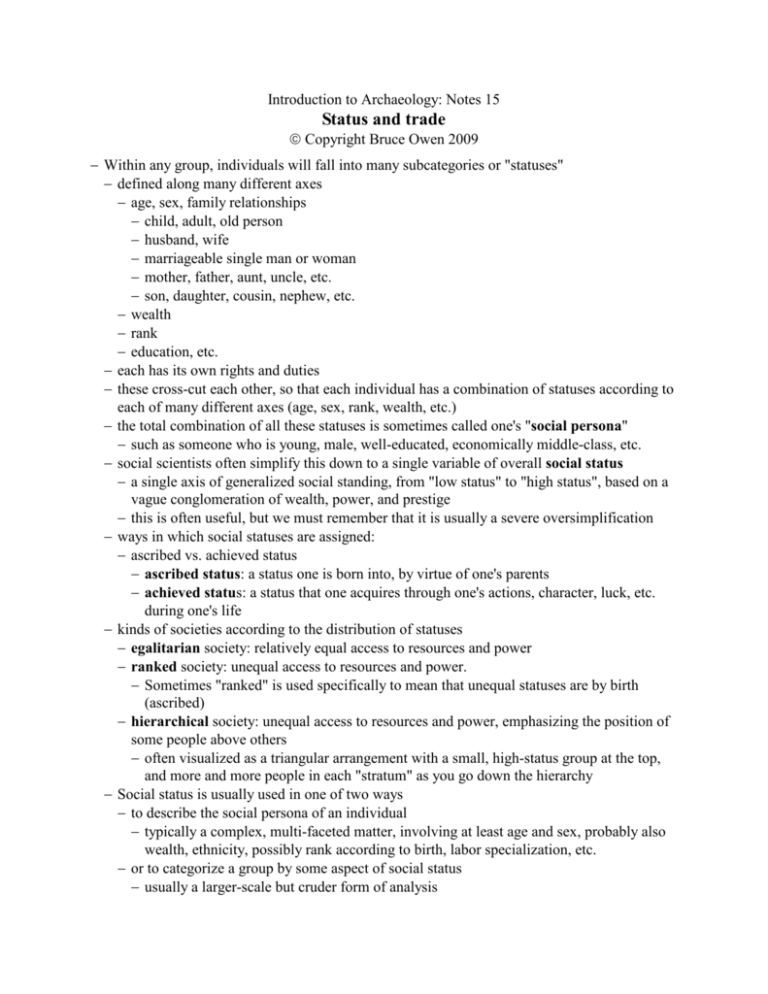
Introduction to Archaeology: Notes 15
Status and trade
Copyright Bruce Owen 2009
− Within any group, individuals will fall into many subcategories or "statuses"
− defined along many different axes
− age, sex, family relationships
− child, adult, old person
− husband, wife
− marriageable single man or woman
− mother, father, aunt, uncle, etc.
− son, daughter, cousin, nephew, etc.
− wealth
− rank
− education, etc.
− each has its own rights and duties
− these cross-cut each other, so that each individual has a combination of statuses according to
each of many different axes (age, sex, rank, wealth, etc.)
− the total combination of all these statuses is sometimes called one's "social persona"
− such as someone who is young, male, well-educated, economically middle-class, etc.
− social scientists often simplify this down to a single variable of overall social status
− a single axis of generalized social standing, from "low status" to "high status", based on a
vague conglomeration of wealth, power, and prestige
− this is often useful, but we must remember that it is usually a severe oversimplification
− ways in which social statuses are assigned:
− ascribed vs. achieved status
− ascribed status: a status one is born into, by virtue of one's parents
− achieved status: a status that one acquires through one's actions, character, luck, etc.
during one's life
− kinds of societies according to the distribution of statuses
− egalitarian society: relatively equal access to resources and power
− ranked society: unequal access to resources and power.
− Sometimes "ranked" is used specifically to mean that unequal statuses are by birth
(ascribed)
− hierarchical society: unequal access to resources and power, emphasizing the position of
some people above others
− often visualized as a triangular arrangement with a small, high-status group at the top,
and more and more people in each "stratum" as you go down the hierarchy
− Social status is usually used in one of two ways
− to describe the social persona of an individual
− typically a complex, multi-faceted matter, involving at least age and sex, probably also
wealth, ethnicity, possibly rank according to birth, labor specialization, etc.
− or to categorize a group by some aspect of social status
− usually a larger-scale but cruder form of analysis
Introduction to Archaeology F 2009 / Owen: Status and trade
p. 2
− such as comparing “elites” versus “commoners”
− how might we recognize "statuses" in the archaeological record?
− different sizes and qualities of residential architecture
− bigger and finer residences were presumably occupied by people of generally higher
status
− which might be wealth, inherited rank, prestige, etc.
− different kinds of materials in household garbage should reflect status
− people who ate more prized kinds of foods or had fancier pottery were presumably of
generally higher status
− burials
− probably the most widely used kind of evidence about status
− useful because a burial contains one individual with objects specifically associated with
that person
− with decent preservation, we can tell the age and sex of the individual from the
physical remains of the body
− and maybe some things about his or her diet, activities, health, injuries, descent from
one or another population, etc.
− versus architecture and midden evidence, which cannot usually be connected to a
specific person of known sex, age, condition, etc.
− one specific claim: rich burials of infants and children suggest ascribed, rather than
achieved, status
− that is, kids have not had time to achieve much
− their burials reflect inherited social personae
− so if they are lavishly buried, status must be inherited
− is this necessarily always true?
− The simple view: burials reflect the social persona of the deceased in life, and
"populations" of burials reflect the social organization of the society in which the people
lived
− generally true at some level
− but not completely, not always
− Burials are not a simple as they might seem
− as we saw last time
− the objects in a burial are placed there by the survivors, not by the deceased
− so they may have a lot to do with the survivors’ agendas, rather than the deceased
person's actual life
− they may or may not be things that the person actually used in life
− they may be things made specifically for burials, like Egyptian copper cutouts
representing objects, rather than the objects themselves
− they may be selected based on ideals, rather than reality
− in our society, one should be buried in formal dress, even if one almost never wore
it in life
− and based on ideas of the supernatural, rather than daily life
− people are never buried with their televisions, video games, or skis, even if those
were very important in their lives
Introduction to Archaeology F 2009 / Owen: Status and trade
p. 3
− because those are seen as inappropriate for burials
− and even aside from all that, grave goods would probably reflect many different,
cross-cutting aspects of the deceased's social persona
− that is, they are influenced by a combination of the person's age, sex, ancestry,
personal relationships in life, activities or specializations, group memberships, etc.
− how can we separate all these things out?
− one approach: statistical analyses of burials
− or grave lots: the set of goods in a burial
− for simple patterns, just divide the burials according to one category and compare the
other variables
− divide by sex; are certain goods found more with males than females?
− divide by age categories (infant, child, young adult, old adult) and compare goods
found with each
− this is fine in simple societies in which only a few variables like age and sex account
for most of the variation
− but when there are more different cross-cutting status systems, the patterns may
become too confusing to detect
− imagine a society in which males are generally buried with more goods than
females
− but both males and females may be shamans, which might increase the wealth of
goods in their burials
− and the wealth of both males and females might be influenced by the family they
were born into
− the net result is a wide, overlapping range of wealth in burials; any one of these
patterns may be very hard to detect
− for these complex cases: fancy statistical techniques like principal component
analysis, cluster analysis, or discriminant analysis
− these essentially plot a large number of variables in multidimensional space, then
"rotate" the "view" of the data to find "angles" that most clearly show clusters
− this helps in discovering variables that tend to covary
− example of a study of individual social personas, in a cemetery population from the
Peruvian site of El Algodonal that I analyzed:
− the main differences in overall quantities of goods were due to age and sex
− subadults had generally fewer grave goods than adults
− with one exception
− but does one rich child burial necessarily imply ascribed status?
− males generally had more grave goods than females
− no particular items were associated with either sex
− right there we have a clue about gender roles and ideology in this society
− maybe the genders were not too drastically different in their activities
− but beyond that, there was a broad tendency for some burials of adults to contain
multiple different plant and animal foods
− versus others that contained fewer or none
Introduction to Archaeology F 2009 / Owen: Status and trade
p. 4
− and a broad tendency for other burials of adults to contain a larger number and
variety of textile items
− versus others that contained fewer
− but the food-rich and textile-rich burials were not necessarily the same burials
− this suggests that there may have been some social role associated with food
production, versus a different one more associated with textile use
− both were found mostly, but not only, with males
− and mostly, but not only, with individuals of higher status (more goods overall)
− maybe suggesting that some males owed their status more to production, and
others more to something involving fancier dress and display, like diplomacy,
politics, ritual, trade…?
− but no other clusters that might suggest craft specialists, like potters versus basket
weavers
− maybe such specialization did not exist
− or it did not play a major role in one's social persona
− or it was not considered appropriate to indicate in a burial
− as we have often seen, this analysis provides some answers, but even more, it
provides information on which to base further hypotheses
− answer: not very marked status differences
− answer: apparently a simple society in which most roles were determined by age
and sex
− hypothesis: not much specialization?
− hypothesis: two routes to higher adult status, one based on food production, and
another based on social interactions like politics or trade?
− Example of an analysis of groups defined by status, from the Upper Mantaro valley,
Peru
− the same project I have referred to before, contrasting the Wanka II (local chiefdoms)
and Wanka III (Inka) periods
− this analysis is by households (patio groups), rather than individuals
− but it lumps the households into two groups for comparison: commoner or elite
− patio groups were classified as common or elite according to
− number of structures in patio group
− proximity to highest, central area and possible public plaza
− quality of masonry
− then the project compared commoner and elite artifact assemblages
− elites had more locally made decorated pottery
− elites had more Inka pottery once the Inka arrived
− elites ate more meat
− elites had more of the copper, and much more of the silver
− with conquest by the Inka, the rich did not get richer
− the Inka used the elites but did not allow them a power base
− elite symbols of status shifted to ones controlled by the Inka
− that fits with the Inka controlling the region through indirect rule
− using the local elites to enforce their rules and demands
Introduction to Archaeology F 2009 / Owen: Status and trade
p. 5
− in part, by making the local elite dependent on the state for the symbols of
status…
− Peebles and Kus analysis of Moundville burials
− a good, now-standard approach that found variations in the quantity and nature of
grave goods
− and inferred social organization from it
− the richest burials in special locations, like in burial mounds, had esoteric items like
copper axes and ornaments, pigments, beads, etc.
− these included children
− were interpreted as an upper stratum of society in which status was largely inherited
− people buried away from these monuments had grave goods that mostly reflected age
and sex
− thus the older adults had more and nicer goods
− these are interpreted as a commoner stratum of society, in which status was
achieved during one's lifetime
− Trade
− Trade is interesting because
− it tells us that people were in contact with each other
− it gives us some idea about the nature and intensity of this contact
− it suggests connections through which other goods, ideas, or even people could have been
exchanged
− it suggests possibilities of influence between cultures
− it gives us some insight into the scale of production, specialization of production
specifically for exchange, availability of wealth for exchange and to capitalize production
for exchange, and so on in the economy of each society
− the paths through which goods circulated, and who ended up with them, can give us a lot
of clues about the organization of wealth and power in a society
− if the trade is over long distances, it suggests that there may have been specialist traders,
and possibly the associated record-keeping, conflict-resolution mechanisms to handle
disputes, and so on
− Basically, trade is identified by finding artifacts in one place that came from some different
place
− The most straightforward way to detect that is by knowing the styles of artifacts
− if a style typical of region A is found in region B, we suspect that the object was traded in
some way
− of course, we cannot be sure from style alone that the artifact is not a locally-made
imitation of a foreign style
− we may be able to tell if the style does not match perfectly
− but there will always be uncertainty about how close the match has to be
− and whether there might be more variation in the source region than we currently know
about
− For some materials, we can use technical means to determine where the material originally
was mined, collected, etc.
Introduction to Archaeology F 2009 / Owen: Status and trade
p. 6
− Most often by geological sourcing, although there are other approaches, too
− obsidian is often sourced using X-ray fluorescence (XRF)
− an instrumental method that gives the approximate amount of each mineral or element
in a material such as obsidian
− lab-based machines and increasingly, portable, hand-held ones
− example: In Peru, we find that the contemporary Tiwanaku and Wari states had their
own, separate sources of obsidian
− they rarely used obsidian from the other’s source
− even in the one valley where sites of both states are literally within sight of each other
− suggests that there was little economic interaction between members of the two states
− which is a bit unusual; usually neighbors trade stuff
− so this may have been a tense or seldom-crossed social boundary
− or each side might just have preferred to use obsidian that came through their own
channels
− in that case, obsidian might have meant more than just a utilitarian material for
making tools out of…
− ceramics are sometimes sourced by trace element composition
− using X-ray fluorescence (XRF)
− using instrumental neutron activation analysis (INAA)
− ceramics are also sometimes sourced by petrographic thin section analysis
− cut a slice of a ceramic sherd, using a special saw
− glue it to a glass microscope slide
− grind it down thin, so light passes through it
− view in a special petrographic microscope, which has polarizing filters both between the
light source and the slide, and between the slide and the eyepieces
− by examining the grains in normal and various combinations and orientations of
polarized light, a specialist can identify many of the minerals present in the ceramic
− especially in the temper (material added to the clay to prevent cracking)
− the combination and relative amounts of different mineral grains may be characteristic
of the particular sources of temper material used
− two general approaches to sourcing
− if there are not too many geological sources of the material
− characterize each one
− then match artifacts to the known sources
− allows you to determine where the material of each artifact came from
− this is fine for materials that come from relatively few sources, like obsidian flows,
some metal deposits, etc.
− if there are countless possible geological sources
− as is the case for clays
− and temper, which can be almost any sand or grit, even ground up shells
− then just describe the composition of lots of samples (sherds, in the case of ceramics)
− look for distinctive clusters or types of composition
− these may come from a single source, even if we don’t know where the source is
Introduction to Archaeology F 2009 / Owen: Status and trade
p. 7
− the more variables (minerals, elements, isotopes) are studied, the more confidence
we can have that a cluster could only come from one source
− then we can plot where the different clusters are found, and estimate the general
location of the source
− and we can get some idea of how widely the material from each source is exchanged
− example: Halaf style ceramics, 5500-4800 BC, on the northern margins of Mesopotamia
− sherds from the same geological source are found up to 600 miles apart
− this indicates that at the very least, pottery was being made in some central location
and being traded up to 300 miles in each direction
− that strongly suggests specialized traders
− and since pottery is heavy, bulky, and fragile, it would have been fairly expensive at
its destination
− so people really wanted these exotic pots for some reason
− and those people were probably fairly well-off elites, who could expend resources
on luxuries
− since from a practical point of view, locally-made ceramics were probably just as
good
− with good sourcing data, we may be able to distinguish between two overall patterns of
exchange
− direct acquisition: in which individuals or settlements got their material or goods by
having someone go directly to the source, acquire the goods, and return with them
− indicated by finding
− little of the material in sites between the source and the use
− or a uniform density in sites, regardless of distance
− either would suggest that each site got the material directly and independently
− this pattern suggests organization and/or specialization for long-distance procurement
− but relatively little inter-group exchange and interaction
− down-the-line exchange: in which people trade with their neighbors, so materials and
goods can move from the source to nearby people, from them to more distant people, and
so on, with no long-distance travel involved
− indicated by finding that the material is common near the source, and declines in density
at sites further and further from the source
− this pattern suggests a less organized or specialized trading system
− but more inter-group exchange and interaction
− identifying these patters could have implications for the flow and control of wealth and
power, and ways of getting them...
− doing that requires good, comparable data from lots of sites that were occupied at the same
general time period
− since the patterns are detected by plotting data from many sites on a map, and looking at
the pattern of drop-off of the material
− good results have been had in Europe, where a lot of good archaeology has been done
− somewhat less so elsewhere, where the data is still often a bit patchy and incomplete for
this sort of analysis

